| Listing 1 - 10 of 26 | << page >> |
Sort by
|
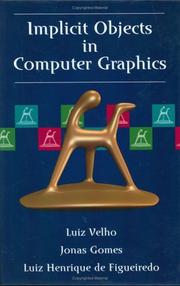
ISBN: 9780387984247 0387984240 9780387216201 9786610188031 1280188030 0387216200 Year: 2002 Publisher: New York, New York : Springer,
Abstract | Keywords | Export | Availability | Bookmark
 Loading...
Loading...Choose an application
- Reference Manager
- EndNote
- RefWorks (Direct export to RefWorks)
Implicit definition and description of geometric objects and surfaces plays a critical role in the appearance and manipulation of computer graphics. In addition, the mathematical definition of shapes, using an implicit form, has pivotal applications for geometric modeling, visualization and animation. Until recently, the parametric form has been by far the most popular geometric representation used in computer graphics and computer-aided design. Whereas parametric objects and the techniques associated with them have been exhaustively developed, the implicit form has been used as a complementary geometric representation, mainly in the restricted context of specific applications. However, recent developments in graphics are changing this situation, and the community is beginning to draw its attention to implicit objects. This is reflected in the current research of aspects related to this subject. Employing a coherent conceptual framework, Implicit Objects in Computer Graphics addresses the role of implicitly defined objects in the following parts: mathematical foundations of geometric models, implicit formulations for the specification of shapes, implicit primitives, techniques for constructing and manipulating implicit objects, modeling, rendering and animating implicit objects.
Computer graphics. --- Infographie --- Computer science. --- Computer vision. --- Optical pattern recognition. --- Computer graphics --- Technology - General --- Engineering & Applied Sciences --- Image processing --- Digital techniques. --- Image processing. --- Pattern recognition. --- Application software. --- Computer Science. --- Computer Applications. --- Computer Graphics. --- Image Processing and Computer Vision. --- Pattern Recognition. --- Optical data processing. --- Design perception --- Pattern recognition --- Form perception --- Perception --- Figure-ground perception --- Optical computing --- Visual data processing --- Bionics --- Electronic data processing --- Integrated optics --- Photonics --- Computers --- Automatic drafting --- Graphic data processing --- Graphics, Computer --- Computer art --- Graphic arts --- Engineering graphics --- Application computer programs --- Application computer software --- Applications software --- Apps (Computer software) --- Computer software --- Optical equipment --- Digital techniques
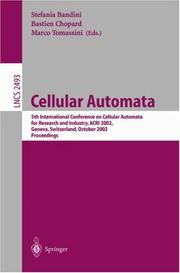
ISSN: 03029743 ISBN: 3540443045 3540458301 9783540443049 Year: 2002 Volume: 2493 Publisher: Berlin, Heidelberg : Springer Berlin Heidelberg : Imprint: Springer,
Abstract | Keywords | Export | Availability | Bookmark
 Loading...
Loading...Choose an application
- Reference Manager
- EndNote
- RefWorks (Direct export to RefWorks)
This volume contains the proceedings of the Fifth International Conference on Cellular Automata for Research and Industry (ACRI 2002) that was held in - neva on October 9–11, 2002. After more modest beginnings in 1994 as a largely Italian conference, over the years ACRI has gradually become ?rmly established as one of the premier conferences in the ?eld of cellular automata in Europe and beyond. Althoughthe?eldofcellularautomataisarelativelyoldandestablishedone, these simple but powerful systems and their newer variations continue to attract the interest of researchers after more than half a century since the seminal work of Ulam and Von Neumann. The ACRI series of conferences has the ambition of being an internationally renowned forum for all those interested in the theory and applications of cellular systems. The contributions collected in this volume concern cellular automata in - rious?eldssuchastheory,implementationsandapplications.Inaddition,several ?eldsofresearch(e.g.themulti-agentsapproach)adoptmethodologiesthatshow strict a?nities to cellular automata, but without the label “Cellular Automata”. Therefore, one of our intentions was to enlarge the cellular automata community to include new related techniques.
Cellular automata --- Algebra --- Mathematics --- Physical Sciences & Mathematics --- Computer science. --- Computers. --- Algorithms. --- Computer simulation. --- Pattern recognition. --- Computer Science. --- Pattern Recognition. --- Simulation and Modeling. --- Computation by Abstract Devices. --- Algorithm Analysis and Problem Complexity. --- Optical pattern recognition. --- Computer software. --- Software, Computer --- Computer systems --- Informatics --- Science --- Computer modeling --- Computer models --- Modeling, Computer --- Models, Computer --- Simulation, Computer --- Electromechanical analogies --- Mathematical models --- Simulation methods --- Model-integrated computing --- Optical data processing --- Pattern perception --- Perceptrons --- Visual discrimination --- Algorism --- Arithmetic --- Automatic computers --- Automatic data processors --- Computer hardware --- Computing machines (Computers) --- Electronic brains --- Electronic calculating-machines --- Electronic computers --- Hardware, Computer --- Cybernetics --- Machine theory --- Calculators --- Cyberspace --- Design perception --- Pattern recognition --- Form perception --- Perception --- Figure-ground perception --- Foundations --- Cellular automata - Congresses
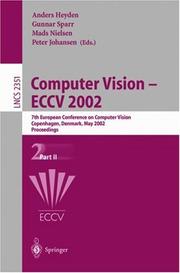
ISBN: 3540437444 3540437460 3540437452 3540479694 3540479678 3540479775 Year: 2002 Publisher: Berlin : Springer,
Abstract | Keywords | Export | Availability | Bookmark
 Loading...
Loading...Choose an application
- Reference Manager
- EndNote
- RefWorks (Direct export to RefWorks)
Premiering in 1990 in Antibes, France, the European Conference on Computer Vision, ECCV, has been held biennially at venues all around Europe. These conferences have been very successful, making ECCV a major event to the computer vision community. ECCV 2002 was the seventh in the series. The privilege of organizing it was shared by three universities: The IT University of Copenhagen, the University of Copenhagen, and Lund University, with the conference venue in Copenhagen. These universities lie ¨ geographically close in the vivid Oresund region, which lies partly in Denmark and partly in Sweden, with the newly built bridge (opened summer 2000) crossing the sound that formerly divided the countries. We are very happy to report that this year’s conference attracted more papers than ever before, with around 600 submissions. Still, together with the conference board, we decided to keep the tradition of holding ECCV as a single track conference. Each paper was anonymously refereed by three different reviewers. For the nal selection, for the rst time for ECCV, a system with area chairs was used. These met with the program chairsinLundfortwodaysinFebruary2002toselectwhatbecame45oralpresentations and 181 posters.Also at this meeting the selection was made without knowledge of the authors’identity.
Conferences - Meetings --- Computer science. --- Artificial intelligence. --- Computer graphics. --- Image processing. --- Pattern recognition. --- Computer Science. --- Image Processing and Computer Vision. --- Computer Graphics. --- Pattern Recognition. --- Artificial Intelligence (incl. Robotics). --- Computer vision --- Pictorial data processing --- Picture processing --- Processing, Image --- Design perception --- Pattern recognition --- Automatic drafting --- Graphic data processing --- Graphics, Computer --- AI (Artificial intelligence) --- Artificial thinking --- Electronic brains --- Intellectronics --- Intelligence, Artificial --- Intelligent machines --- Machine intelligence --- Thinking, Artificial --- Informatics --- Imaging systems --- Optical data processing --- Form perception --- Perception --- Figure-ground perception --- Computer art --- Graphic arts --- Electronic data processing --- Engineering graphics --- Image processing --- Bionics --- Cognitive science --- Digital computer simulation --- Logic machines --- Machine theory --- Self-organizing systems --- Simulation methods --- Fifth generation computers --- Neural computers --- Science --- Digital techniques --- Computer vision. --- Optical pattern recognition. --- Artificial Intelligence. --- Pattern perception --- Perceptrons --- Visual discrimination --- Machine vision --- Vision, Computer --- Artificial intelligence --- Pattern recognition systems --- Optical data processing. --- Optical computing --- Visual data processing --- Integrated optics --- Photonics --- Computers --- Optical equipment
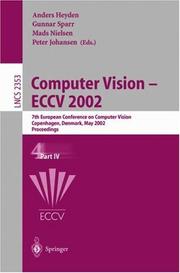
ISBN: 3540479791 3540437487 Year: 2002 Publisher: Berlin : Springer,
Abstract | Keywords | Export | Availability | Bookmark
 Loading...
Loading...Choose an application
- Reference Manager
- EndNote
- RefWorks (Direct export to RefWorks)
Premiering in 1990 in Antibes, France, the European Conference on Computer Vision, ECCV, has been held biennially at venues all around Europe. These conferences have been very successful, making ECCV a major event to the computer vision community. ECCV 2002 was the seventh in the series. The privilege of organizing it was shared by three universities: The IT University of Copenhagen, the University of Copenhagen, and Lund University, with the conference venue in Copenhagen. These universities lie ¨ geographically close in the vivid Oresund region, which lies partly in Denmark and partly in Sweden, with the newly built bridge (opened summer 2000) crossing the sound that formerly divided the countries. We are very happy to report that this year’s conference attracted more papers than ever before, with around 600 submissions. Still, together with the conference board, we decided to keep the tradition of holding ECCV as a single track conference. Each paper was anonymously refereed by three different reviewers. For the nal selection, for the rst time for ECCV, a system with area chairs was used. These met with the program chairsinLundfortwodaysinFebruary2002toselectwhatbecame45oralpresentations and 181 posters.Also at this meeting the selection was made without knowledge of the authors’identity.
Applied Physics --- Engineering & Applied Sciences --- Computer vision --- Computer science. --- Artificial intelligence. --- Computer graphics. --- Image processing. --- Pattern recognition. --- Computer Science. --- Image Processing and Computer Vision. --- Computer Graphics. --- Pattern Recognition. --- Artificial Intelligence (incl. Robotics). --- Computer vision. --- Optical pattern recognition. --- Artificial Intelligence. --- AI (Artificial intelligence) --- Artificial thinking --- Electronic brains --- Intellectronics --- Intelligence, Artificial --- Intelligent machines --- Machine intelligence --- Thinking, Artificial --- Bionics --- Cognitive science --- Digital computer simulation --- Electronic data processing --- Logic machines --- Machine theory --- Self-organizing systems --- Simulation methods --- Fifth generation computers --- Neural computers --- Optical data processing --- Pattern perception --- Perceptrons --- Visual discrimination --- Automatic drafting --- Graphic data processing --- Graphics, Computer --- Computer art --- Graphic arts --- Engineering graphics --- Image processing --- Machine vision --- Vision, Computer --- Artificial intelligence --- Pattern recognition systems --- Digital techniques --- Optical data processing. --- Design perception --- Pattern recognition --- Form perception --- Perception --- Figure-ground perception --- Optical computing --- Visual data processing --- Integrated optics --- Photonics --- Computers --- Optical equipment
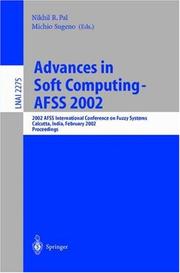
ISBN: 3540431500 3540456317 Year: 2002 Publisher: Berlin, Heidelberg : Springer Berlin Heidelberg : Imprint: Springer,
Abstract | Keywords | Export | Availability | Bookmark
 Loading...
Loading...Choose an application
- Reference Manager
- EndNote
- RefWorks (Direct export to RefWorks)
It is our great pleasure to welcome you all to the 2002 AFSS International Conference on Fuzzy Systems (AFSS 2002) to be held in Calcutta, the great City of Joy. AFSS 2002 is the ?fth conference in the series initiated by the Asian Fuzzy Systems Society (AFSS). AFSS 2002 is jointly being organized by theIndianStatisticalInstitute(ISI)andJadavpurUniversity(JU). Likeprevious conferencesinthisseries,wearesure,AFSS2002willprovideaforumforfruitful interaction and exchange of ideas between the participants from all over the globe. The present conference covers all major facets of soft computing such as fuzzy logic, neural networks, genetic algorithms including both theories and applications. Wehopethismeetingwillbeenjoyableacademicallyandotherwise. We are thankful to the members of the International Program Committee and the Area Chairs for extending their support in various forms to make a strong technical program. Each submitted paper was reviewed by at least three referees, and in some cases the revised versions were again checked by the ref- ees. As a result of this tough screening process we could select only about 50% of the submitted papers. We again express our sincere thanks to all referees for doing a great job. We are happy to note that 19 di?erent countries from all over the globe are represented by the authors, thereby making it a truly inter- tional conference. We are proud to have a list of distinguished speakers including Profs. Z. Pawlak, J. Bezdek, D. Dubois, and T. Yamakawa.
Soft computing --- Neural networks (Computer science) --- Fuzzy systems --- Computer Science --- Engineering & Applied Sciences --- Engineering. --- Artificial intelligence. --- Image processing. --- Pattern recognition. --- Robotics. --- Automation. --- Robotics and Automation. --- Image Processing and Computer Vision. --- Pattern Recognition. --- Artificial Intelligence (incl. Robotics). --- Computer vision. --- Optical pattern recognition. --- Artificial Intelligence. --- AI (Artificial intelligence) --- Artificial thinking --- Electronic brains --- Intellectronics --- Intelligence, Artificial --- Intelligent machines --- Machine intelligence --- Thinking, Artificial --- Bionics --- Cognitive science --- Digital computer simulation --- Electronic data processing --- Logic machines --- Machine theory --- Self-organizing systems --- Simulation methods --- Fifth generation computers --- Neural computers --- Optical data processing --- Pattern perception --- Perceptrons --- Visual discrimination --- Machine vision --- Vision, Computer --- Artificial intelligence --- Image processing --- Pattern recognition systems --- Optical data processing. --- Design perception --- Pattern recognition --- Form perception --- Perception --- Figure-ground perception --- Optical computing --- Visual data processing --- Integrated optics --- Photonics --- Computers --- Automatic factories --- Automatic production --- Computer control --- Engineering cybernetics --- Factories --- Industrial engineering --- Mechanization --- Assembly-line methods --- Automatic control --- Automatic machinery --- CAD/CAM systems --- Robotics --- Automation --- Optical equipment
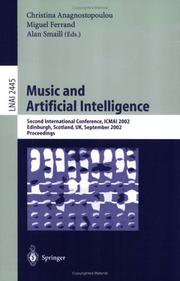
ISBN: 3540457224 354044145X Year: 2002 Publisher: Berlin, Heidelberg : Springer Berlin Heidelberg : Imprint: Springer,
Abstract | Keywords | Export | Availability | Bookmark
 Loading...
Loading...Choose an application
- Reference Manager
- EndNote
- RefWorks (Direct export to RefWorks)
Artificial intelligence --- Music Literature --- Music --- Music, Dance, Drama & Film --- Musical applications --- AI (Artificial intelligence) --- Artificial thinking --- Electronic brains --- Intellectronics --- Intelligence, Artificial --- Intelligent machines --- Machine intelligence --- Thinking, Artificial --- Computer science. --- Music. --- Artificial intelligence. --- Pattern recognition. --- Application software. --- Computer Science. --- Artificial Intelligence (incl. Robotics). --- Computer Appl. in Arts and Humanities. --- Pattern Recognition. --- Bionics --- Cognitive science --- Digital computer simulation --- Electronic data processing --- Logic machines --- Machine theory --- Self-organizing systems --- Simulation methods --- Fifth generation computers --- Neural computers --- Information systems. --- Optical pattern recognition. --- Artificial Intelligence. --- Art music --- Art music, Western --- Classical music --- Musical compositions --- Musical works --- Serious music --- Western art music --- Western music (Western countries) --- Design perception --- Pattern recognition --- Form perception --- Perception --- Figure-ground perception --- Application computer programs --- Application computer software --- Applications software --- Apps (Computer software) --- Computer software
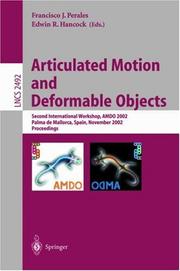
ISBN: 3540361383 3540001492 Year: 2002 Publisher: Berlin, Heidelberg : Springer Berlin Heidelberg : Imprint: Springer,
Abstract | Keywords | Export | Availability | Bookmark
 Loading...
Loading...Choose an application
- Reference Manager
- EndNote
- RefWorks (Direct export to RefWorks)
Computer graphics --- Computer animation --- Technology - General --- Engineering & Applied Sciences --- Computer science. --- Artificial intelligence. --- Computer simulation. --- Computer graphics. --- Image processing. --- Pattern recognition. --- Computer Science. --- Simulation and Modeling. --- Image Processing and Computer Vision. --- Artificial Intelligence (incl. Robotics). --- Computer Graphics. --- Pattern Recognition. --- Computer vision. --- Optical pattern recognition. --- Artificial Intelligence. --- Optical data processing --- Pattern perception --- Perceptrons --- Visual discrimination --- Automatic drafting --- Graphic data processing --- Graphics, Computer --- Computer art --- Graphic arts --- Electronic data processing --- Engineering graphics --- Image processing --- AI (Artificial intelligence) --- Artificial thinking --- Electronic brains --- Intellectronics --- Intelligence, Artificial --- Intelligent machines --- Machine intelligence --- Thinking, Artificial --- Bionics --- Cognitive science --- Digital computer simulation --- Logic machines --- Machine theory --- Self-organizing systems --- Simulation methods --- Fifth generation computers --- Neural computers --- Machine vision --- Vision, Computer --- Artificial intelligence --- Pattern recognition systems --- Computer modeling --- Computer models --- Modeling, Computer --- Models, Computer --- Simulation, Computer --- Electromechanical analogies --- Mathematical models --- Model-integrated computing --- Digital techniques --- Optical data processing. --- Optical computing --- Visual data processing --- Integrated optics --- Photonics --- Computers --- Design perception --- Pattern recognition --- Form perception --- Perception --- Figure-ground perception --- Optical equipment
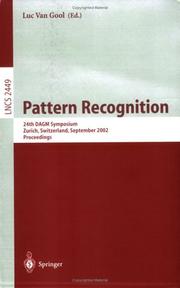
ISBN: 3540457836 354044209X Year: 2002 Publisher: Berlin, Heidelberg : Springer Berlin Heidelberg : Imprint: Springer,
Abstract | Keywords | Export | Availability | Bookmark
 Loading...
Loading...Choose an application
- Reference Manager
- EndNote
- RefWorks (Direct export to RefWorks)
We are proud to present the DAGM 2002 proceedings, which are the result of the e?orts of many people. First, there are the many authors, who have submitted so many excellent cont- butions. We received more than 140 papers, of which we could only accept about half in order not to overload the program. Only about one in seven submitted papers could be delivered as an oral presentation, for the same reason. But it needs to be said that almost all submissions were of a really high quality. This strong program could not have been put together without the support of the Program Committee. They took their responsibility most seriously and we are very grateful for their reviewing work, which certainly took more time than anticipated, given the larger than usual number of submissions. Our three invited speakers added a strong multidisciplinary component to the conference. Dr. Antonio Criminisi of Microsoft Research (Redmond, USA) dem- strated how computer vision can literally bring a new dimension to the app- ciation of art. Prof. Philippe Schyns (Dept. of Psychology, Univ. of Glasgow, UK) presented intriguing insights into the human perception of patterns, e.g., the role of scale. Complementary to this presentation, Prof. Manabu Tanifuji of the Brain Science Institute in Japan (Riken) discussed novel neurophysiological ?ndings on how the brain deals with the recognition of objects and their parts.
Optical pattern recognition --- Image processing --- Pattern recognition systems --- Applied Physics --- Engineering & Applied Sciences --- Digital techniques --- Computer science. --- Artificial intelligence. --- Computer graphics. --- Image processing. --- Pattern recognition. --- Computer Science. --- Pattern Recognition. --- Image Processing and Computer Vision. --- Artificial Intelligence (incl. Robotics). --- Computer Graphics. --- Optical pattern recognition. --- Computer vision. --- Artificial Intelligence. --- Automatic drafting --- Graphic data processing --- Graphics, Computer --- Computer art --- Graphic arts --- Electronic data processing --- Engineering graphics --- AI (Artificial intelligence) --- Artificial thinking --- Electronic brains --- Intellectronics --- Intelligence, Artificial --- Intelligent machines --- Machine intelligence --- Thinking, Artificial --- Bionics --- Cognitive science --- Digital computer simulation --- Logic machines --- Machine theory --- Self-organizing systems --- Simulation methods --- Fifth generation computers --- Neural computers --- Machine vision --- Vision, Computer --- Artificial intelligence --- Optical data processing --- Pattern perception --- Perceptrons --- Visual discrimination --- Optical data processing. --- Optical computing --- Visual data processing --- Integrated optics --- Photonics --- Computers --- Design perception --- Pattern recognition --- Form perception --- Perception --- Figure-ground perception --- Optical equipment
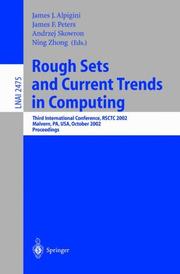
ISBN: 3540458131 354044274X Year: 2002 Publisher: Berlin, Heidelberg : Springer Berlin Heidelberg : Imprint: Springer,
Abstract | Keywords | Export | Availability | Bookmark
 Loading...
Loading...Choose an application
- Reference Manager
- EndNote
- RefWorks (Direct export to RefWorks)
This volume contains the papers selected for presentation at the Third Inter- tional Conference on Rough Sets and Current Trends in Computing (RSCTC 2002) held at Penn State Great Valley, Malvern, Pennsylvania, U.S.A., 14–16 October 2002. Rough set theoryand its applications constitute a branch of soft computing that has exhibited a signi?cant growth rate during recent years. RSCTC 2002 provided a forum for exchanging ideas among manyresearchers in the rough set communityand in various areas of soft computing and served as a stimulus for mutual understanding and cooperation. In recent years, there have been a number of advances in rough set theoryand applications. Hence, we have witnessed a growing number of international workshops on rough sets and their applications. In addition, it should be observed that one of the beauties of rough sets and the rough set philosophyis that it tends to complement and reinforce research in manytraditional research areas and applications. This is the main reason that manyinternational conferences are now including rough sets into the list of topics.
Electronic data processing --- Rough sets --- Computer Science --- Engineering & Applied Sciences --- Rough set theory --- Theory of rough sets --- Computer science. --- Software engineering. --- Computers. --- Mathematical logic. --- Artificial intelligence. --- Pattern recognition. --- Computer Science. --- Theory of Computation. --- Software Engineering/Programming and Operating Systems. --- Artificial Intelligence (incl. Robotics). --- Mathematical Logic and Formal Languages. --- Computation by Abstract Devices. --- Pattern Recognition. --- Design perception --- Pattern recognition --- Form perception --- Perception --- Figure-ground perception --- AI (Artificial intelligence) --- Artificial thinking --- Electronic brains --- Intellectronics --- Intelligence, Artificial --- Intelligent machines --- Machine intelligence --- Thinking, Artificial --- Bionics --- Cognitive science --- Digital computer simulation --- Logic machines --- Machine theory --- Self-organizing systems --- Simulation methods --- Fifth generation computers --- Neural computers --- Algebra of logic --- Logic, Universal --- Mathematical logic --- Symbolic and mathematical logic --- Symbolic logic --- Mathematics --- Algebra, Abstract --- Metamathematics --- Set theory --- Syllogism --- Automatic computers --- Automatic data processors --- Computer hardware --- Computing machines (Computers) --- Electronic calculating-machines --- Electronic computers --- Hardware, Computer --- Computer systems --- Cybernetics --- Calculators --- Cyberspace --- Computer software engineering --- Engineering --- Informatics --- Science --- Information theory. --- Optical pattern recognition. --- Artificial Intelligence.
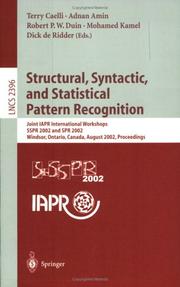

ISBN: 3540440119 3540706593 Year: 2002 Publisher: Berlin, Heidelberg : Springer Berlin Heidelberg : Imprint: Springer,
Abstract | Keywords | Export | Availability | Bookmark
 Loading...
Loading...Choose an application
- Reference Manager
- EndNote
- RefWorks (Direct export to RefWorks)
This volume contains all papers presented at SSPR 2002 and SPR 2002 hosted by the University of Windsor, Windsor, Ontario, Canada, August 6-9, 2002. This was the third time these two workshops were held back-to-back. SSPR was the ninth International Workshop on Structural and Syntactic Pattern Recognition and the SPR was the fourth International Workshop on Statis- cal Techniques in Pattern Recognition. These workshops have traditionally been held in conjunction with ICPR (International Conference on Pattern Recog- tion), and are the major events for technical committees TC2 and TC1, resp- tively, of the International Association of Pattern Recognition (IAPR). The workshops were held in parallel and closely coordinated. This was an attempt to resolve the dilemma of how to deal, in the light of the progressive specialization of pattern recognition, with the need for narrow-focus workshops without further fragmenting the ?eld and introducing yet another conference that would compete for the time and resources of potential participants. A total of 116 papers were received from many countries with the submission and reviewingprocesses beingcarried out separately for each workshop. A total of 45 papers were accepted for oral presentation and 35 for posters. In addition four invited speakers presented informative talks and overviews of their research. They were: Tom Dietterich, Oregon State University, USA Sven Dickinson, the University of Toronto, Canada Edwin Hancock, University of York, UK Anil Jain, Michigan State University, USA SSPR 2002 and SPR 2002 were sponsored by the IAPR and the University of Windsor.
Optical pattern recognition. --- Computer vision. --- Artificial intelligence. --- Computer science. --- Pattern Recognition. --- Image Processing and Computer Vision. --- Artificial Intelligence. --- Probability and Statistics in Computer Science. --- Informatics --- Science --- Machine vision --- Vision, Computer --- Artificial intelligence --- Image processing --- Pattern recognition systems --- AI (Artificial intelligence) --- Artificial thinking --- Electronic brains --- Intellectronics --- Intelligence, Artificial --- Intelligent machines --- Machine intelligence --- Thinking, Artificial --- Bionics --- Cognitive science --- Digital computer simulation --- Electronic data processing --- Logic machines --- Machine theory --- Self-organizing systems --- Simulation methods --- Fifth generation computers --- Neural computers --- Optical data processing --- Pattern perception --- Perceptrons --- Visual discrimination --- Pattern recognition. --- Optical data processing. --- Mathematical statistics. --- Mathematics --- Statistical inference --- Statistics, Mathematical --- Statistics --- Probabilities --- Sampling (Statistics) --- Optical computing --- Visual data processing --- Integrated optics --- Photonics --- Computers --- Design perception --- Pattern recognition --- Form perception --- Perception --- Figure-ground perception --- Statistical methods --- Optical equipment
| Listing 1 - 10 of 26 | << page >> |
Sort by
|

 Search
Search Feedback
Feedback About UniCat
About UniCat  Help
Help News
News